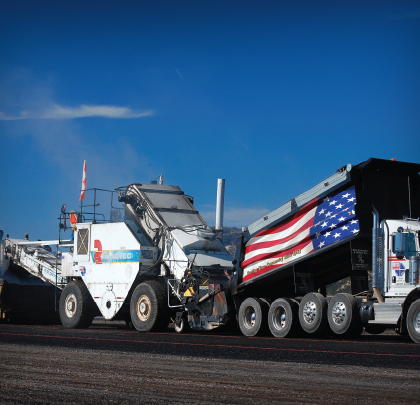Full Reconstruction of Colorado’s Meeker Airport Sees Blue Sky
Located in Meeker, Colorado, and serving the area for air transportation, is Meeker Airport, a C-II general aviation airport. The FAA designation of C-II means the airport can accommodate aircraft with wingspan of less than 79 feet. The airport is critical to residents and businesses in Rio Blanco County.
Runway 3-21 at the county-owned Meeker Airport had reached a point of wear and deterioration that required full reconstruction and upgrades to remain compliant with the FAA’s C-II requirements.
THE PROJECT
The project, which was awarded to Fiore & Sons, Inc., was a two-stage project with a contract value of $12.5 million. Construction consisted of the demolition of the existing 60-foot-wide by 6,500-foot-long runway and the construction of a new runway to meet C-II runway safety area and longitudinal standards. The new runway was widened to 100 feet—nearly doubling its width—and remained 6,500 feet long. The runway ties into the existing apron connector with a teacup style turnaround on the 21 end of the runway.
Fiore & Sons completed the demotion and removed 43,000 square yards of rotomilled asphalt in preparation for the site conditioning, grading, and paving completed by United Companies of Mesa County, headquartered in Grand Junction, Colorado.
“We were responsible for base course and paving of the new runway and the overall construction of the large apron and taxiway,” states Jeff Boone, project manager for United Companies. “We needed to complete our portions of the combined projects within the 8-month timeline for the whole project, so our timing was tight.”
United Companies had two major responsibilities in the project: the dirt and stone work to create the subbase and the finish paving on the runway, apron, and the aircraft turnaround.
After Fiore & Sons completed the demo of the old runway and moved 1,000,000 cubic yards to rebuild the runway, United Companies came on-site and moved 100,000 yards of dirt for the large apron and taxiway. Between the two projects the company placed 70,000 tons or 35,000 cubic yards of p154 and p209 crushed aggregate base course and in 6-inch lifts with the company’s three Caterpillar 140H motorgraders equipped with Topcon 3D-MC2machine control.
“The Topcon system helped us achieve more accurate placement of the base materials at higher speeds and better tolerances,” says Jeff Gross, GPS machine control foreman for United Companies.
“With a tight production deadline and stringent FAA requirements, it helped to have the technology.”
GDA Engineers provided the project control points, as well as the points for drainage and utilities for the Meeker Airport project.
“A tremendous amount of time and money was saved because we didn’t need to be setting grade stakes,” says Ken Dobey, construction manager for United Companies. “United Companies created the 3D site model which our GPS machine control could use—thus, the job was virtually stakeless.”
Dobey points out that the company has been an early adopter of technology for the past 15 years, with GPS machine control in use for the past 4 years. “Our business approach is to be at the cutting edge of technology,” Dobey states. “We’ve found that our investments in technology save us time and resources.”
TECHNOLOGY ADVANTAGE
In keeping with its technology adoption approach, United Companies recently added Topcon Millimeter GPS Asphalt Paver Systems to its three Cat AP-1055D pavers. The Topcon system uses what Topcon refers to as LazerZone™ technology, which uses GPS positioning together with a zone laser reference provided by a PZL-1A rotating laser, which is said to transmit a signal that creates a measuring area 10 meters (33 feet) in height.
On the first day of paving, United Companies paved two 600-foot-long test strips measuring 16 feet wide using FAA-specified HMA. Sample cores were taken from the 2-inch thick lift to ensure compliance. The paver guided by the Topcon paving control system provided results well within compliance.
To pave the 100-foot by 6,500-foot-long runway, United Companies arranged three PZL-1A rotating lasers spaced 500 feet apart and then leap-frogged them to maintain continuous production flow. A Roadtec SB-2500e material transport vehicle was used to ensure the hot-mix asphalt was delivered consistently to the paver at the correct temperature and mix.
“We were quite pleased with the results from the Millimeter GPS system,” Gross says. “We completed our work faster than expected and the results were superior; only 16 out of the 2,500 test shots were out of compliance and none required corrective action.”
In addition to the main runway, United Companies paved a 650-foot by 320-foot apron and a 1,200-foot-long by 50-foot-wide taxiway.The complete Meeker Airport job required six layers that each needed to be checked for smoothness. The first layer was a graded dirt layer followed by three 6-inch lifts of the P-154 subbase course. The fifth layer was a 6-inch lift of PT-209 base course. And the top layer is two 2-inch lifts of FAA-specified HMA.
“If we had needed to complete all of this work the old way using survey crews and pounding wood, it probably would have taken us two to three times longer … the technology is that beneficial,” Boone says. “And we can’t argue about the quality of the finished results … the smoothness of the runway pavement can speak for itself.”
■ ■ ■
[divider]
ABOUT THE AUTHOR
Jeff Winke is a business and construction writer based in Milwaukee, Wisconsin. He can be reached through www.jeffwinke.com.
Modern Contractor Solutions, MAY 2014
Did you enjoy this article?
Subscribe to the FREE Digital Edition of Modern Contractor Solutions Magazine!


